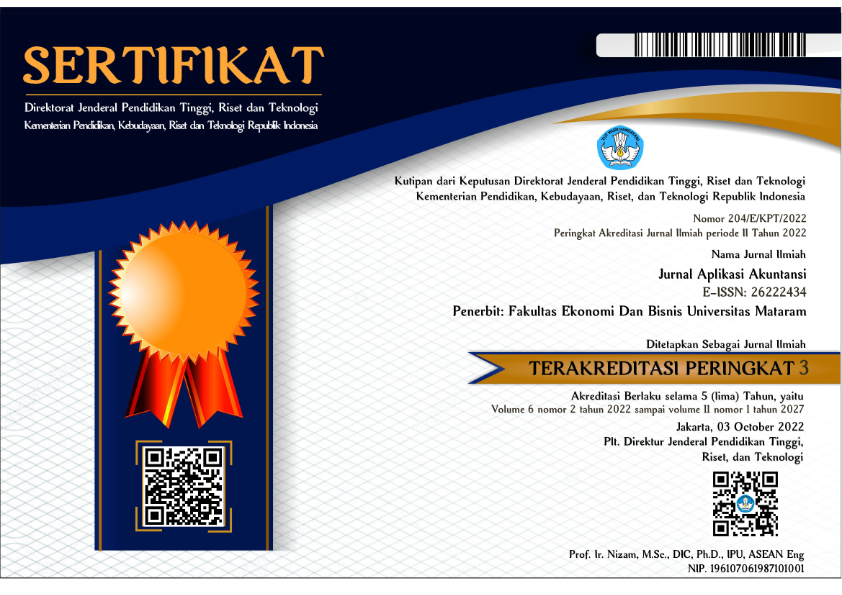DAMPAK GREEN INTELLECTUAL CAPITAL TERHADAP GREEN INNOVATION DALAM MENINGKATKAN NILAI PERUSAHAAN MELALUI KINERJA KEUANGAN
DOI:
https://doi.org/10.29303/jaa.v8i2.409Keywords:
green intellectual capital, green innovation, kinerja keuangan, nilai perusahaan.Abstract
Meningkatnya kepedulian masyarakat global terhadap isu-isu lingkungan hidup telah mengakibatkan meningkatnya tekanan dan pengawasan dari para pemangku kepentingan. Untuk itu penting diteliti seberapa besar pengaruh atau peranan dari green innovation dalam meningkatkan nilai perusahaan melalui kinerja keuangan. Selain itu penelitian ini juga akan melihat kontribusi green intellectual capital dalam meningkatkan green innovation. Hasil penelitian ini memperlihatkan bahwa keberadaan green intellectual capital dapat menstimulasi terciptanya green innovation, di mana green innovation sendiri juga terbukti mampu meningkatkan nilai perusahaan melalui kinerja keuangan. Hasil penelitian ini mendorong industri menghasilkan produk-produk yang ramah lingkungan dan inovatif agar tercipta peningkatan nilai perusahaan melalui pertumbuhan di sektor kinerja keuangan. Dunia usaha juga perlu menumbuhkembangkan green intellectual capital agar banyak menghasilkan ide-ide dalam menciptakan green innovation.
References
Aguilera-Caracuel, J., & Ortiz-de-Mandojana, N. (2013). Green Innovation and Financial Performance: An Institutional Approach. Organization and Environment, 26(4), 365–385. https://doi.org/10.1177/1086026613507931
Agustia, D., Sawarjuwono, T., & Dianawati, W. (2019). The mediating effect of environmental management accounting on green innovation - Firm value relationship. International Journal of Energy Economics and Policy, 9(2), 299–306. https://doi.org/10.32479/ijeep.7438
Alamudi, A. Al. (2022). Menilik Perusahaan di Berbagai Daerah yang Limbahnya Bikin Resah Artikel ini telah tayang di Idntimes.com dengan judul “Menilik Perusahaan di Berbagai Daerah yang Limbahnya Bikin Resah”. Klik untuk baca: https://sumut.idntimes.com/news/indonesia/arifin-alamudi/menilik-perusahaan-di-berbagai-daerah-yang-limbahnya-bikin-resah.
Alos-Simo, L., Verdu-Jover, A. J., & Gomez-Gras, J. M. (2020). Does activity sector matter for the relationship between eco-innovation and performance? Implications for cleaner production. Journal of Cleaner Production, 263. https://doi.org/10.1016/j.jclepro.2020.121544
Asiaei, K., O’Connor, N. G., Barani, O., & Joshi, M. (2023). Green intellectual capital and ambidextrous green innovation: The impact on environmental performance. Business Strategy and the Environment, 32(1), 369–386. https://doi.org/10.1002/bse.3136
Asni, N., & Agustia, D. (2022). The mediating role of financial performance in the relationship between green innovation and firm value: evidence from ASEAN countries. European Journal of Innovation Management, 25(5), 1328–1347. https://doi.org/10.1108/EJIM-11-2020-0459
Barney, J. (1991). Firm Resources and Sustained Competitive Advantage. Journal of Management, 17(1), 99–120. https://doi.org/10.1177/014920639101700108
Bıçakcıoğlu, N., Theoharakis, V., & Tanyeri, M. (2020). Green business strategy and export performance: An examination of boundary conditions from an emerging economy. International Marketing Review, 37(1), 56–75. https://doi.org/10.1108/IMR-11-2018-0317
Cai, W., & Li, G. (2018). The drivers of eco-innovation and its impact on performance: Evidence from China. Journal of Cleaner Production, 176, 110–118. https://doi.org/10.1016/j.jclepro.2017.12.109
Chen, Y. S. (2008). The Positive Effect of Green Intellectual Capital on Competitive Advantages of Firms. Journal of Business Ethics, 77(3), 271–286. https://doi.org/10.1007/s10551-006-9349-1
Christmann, P. (2000). Effects of “Best Practices” of Environmental Management on Cost Advantage: The Role of Complementary Assets. In Source: The Academy of Management Journal (Vol. 43, Issue 4).
Clarkson, P. M., Li, Y., Rotman, J., Richardson, G. D., & Vasvari, F. P. (2010). Does it Really Pay to be Green? Determinants and Consequences of Proactive Environmental Strategies. Journal of Accounting and Public Policy, 30(2), 122–140. http://ssrn.com/abstract=1655969Electroniccopyavailableat:https://ssrn.com/abstract=1655969Electroniccopyavailableat:http://ssrn.com/abstract=1655969Electroniccopyavailableat:https://ssrn.com/abstract=1655969
Direktorat Jenderal Pengendalian Pencemaran dan Kerusakan Lingkungan Hidup. (2020). Laporan Indeks Kualitas Lingkungan Hidup 2019.
Direktorat Jenderal Pengendalian Pencemaran dan Kerusakan Lingkungan Hidup. (2021). Laporan Indeks Kualitas Lingkungan Hidup 2021.
Festus, O. S., & Akinselure, O. P. (2017). Impact of Environment Accounting on Financial Performance of Seleted Quoted Companies. In International Research Journal of Management and Commerce ISSN (Vol. 4, Issue 11). www.aarf.asia,
Gantino, R., Ruswanti, E., & Widodo, A. M. (n.d.). Green Accounting And Intellectual Capital Effect On Firm Value Moderated By Business Strategy. https://doi.org/10.24912/jm.v27i1.1118
Ghozali, I. (2018). Aplikasi Analisis Multivariate dengan Program IBM SPSS 25 (9th ed.).
Hahn, T., Preuss, L., Pinkse, J., & Figge, F. (2014). Cognitive frames in corporate sustainability: Managerial sensemaking with paradoxical and business case frames. Academy of Management Review, 39(4), 463–487. https://doi.org/10.5465/amr.2012.0341
Harrison, J. S., & Wicks, A. C. (2013). Stakeholder Theory, Value, and Firm Performance. Business Ethics Quarterly, 23(1), 97–124. https://doi.org/10.5840/beq20132314
Hart, S. L., & Hart, S. L. (2013). A NATURAL-RESOURCE-BASED VIEW OF THE FIRM. 20(4), 986–1014.
Hojnik, J., Ruzzier, M., & Manolova, T. (2017). Eco-innovation and firm efficiency: Empirical evidence from Slovenia. Foresight and STI Governance, 11(3), 103–111. https://doi.org/10.17323/2500-2597.2017.3.103.111
Jirakraisiri, J., Badir, Y. F., & Frank, B. (2021). Translating green strategic intent into green process innovation performance: the role of green intellectual capital. Journal of Intellectual Capital, 22(7), 43–67. https://doi.org/10.1108/JIC-08-2020-0277
Komara, A., Ghozali, I., & Januarti, I. (2023). Examining the Firm Value Based on Signaling Theory. Jurnal Akuntansi, 27(1), 38–61.
Li, S., Ngniatedema, T., & Chen, F. (2017). Understanding the Impact of Green Initiatives and Green Performance on Financial Performance in the US. Business Strategy and the Environment, 26(6), 776–790. https://doi.org/10.1002/bse.1948
Liao, L., Chen, G., & Zheng, D. (2019). Corporate social responsibility and financial fraud: evidence from China. Accounting and Finance, 59(5), 3133–3169. https://doi.org/10.1111/acfi.12572
Liao, Z. (2018). Corporate culture, environmental innovation and financial performance. Business Strategy and the Environment, 27(8), 1368–1375. https://doi.org/10.1002/bse.2186
Liu, D., Yu, X., Huang, M., Yang, S., Isa, S. M., & Hu, M. (2022a). The Effects of Green Intellectual Capital on Green Innovation: A Green Supply Chain Integration Perspective. Frontiers in Psychology, 13. https://doi.org/10.3389/fpsyg.2022.830716
Liu, D., Yu, X., Huang, M., Yang, S., Isa, S. M., & Hu, M. (2022b). The Effects of Green Intellectual Capital on Green Innovation: A Green Supply Chain Integration Perspective. Frontiers in Psychology, 13. https://doi.org/10.3389/fpsyg.2022.830716
Marco-Lajara, B., Zaragoza-Sáez, P., Martínez-Falcó, J., & Ruiz-Fernández, L. (2022). The Effect of Green Intellectual Capital on Green Performance in the Spanish Wine Industry: A Structural Equation Modeling Approach. Complexity, 2022. https://doi.org/10.1155/2022/6024077
Mishra, D. R. (2017). Post-innovation CSR Performance and Firm Value. Journal of Business Ethics, 140(2), 285–306. https://doi.org/10.1007/s10551-015-2676-3
Moini, H., Sorensen, O. J., & Szuchy-Kristiansen, E. (2014). Adoption of green strategy by Danish firms. Sustainability Accounting, Management and Policy Journal, 5(2), 197–223. https://doi.org/10.1108/SAMPJ-01-2013-0003
Ong, Lee, Teh, & Magsi. (2019). Environmental Innovation, Environmental Performance and Financial Performance: Evidence from Malaysian Environmental Proactive Firms. Sustainability, 11(12), 3494. https://doi.org/10.3390/su11123494
Rehman, S. U., Kraus, S., Shah, S. A., Khanin, D., & Mahto, R. V. (2021). Analyzing the relationship between green innovation and environmental performance in large manufacturing firms. Technological Forecasting and Social Change, 163. https://doi.org/10.1016/j.techfore.2020.120481
Rezende, L. de A., Bansi, A. C., Alves, M. F. R., & Galina, S. V. R. (2019). Take your time: Examining when green innovation affects financial performance in multinationals. Journal of Cleaner Production, 233, 993–1003. https://doi.org/10.1016/j.jclepro.2019.06.135
Rusli, Y. M., Augustine, Y., Murwaningsari, E., & Breliastiti, R. (2019). The Moderating Effect of Competitive Business Strategy on Corporate Environmental Performance and Corporate Carbon Emission Disclosure Towards Corporate Financial Performance. Journal of Economics and Sustainable Development, 10(6). https://doi.org/10.7176/JESD
Setiawan, T., Jonathan, N., & Kurniawati, K. (2022). Indicator Development And Quality Of Corporate Social Responsibility Disclosure For The Mining Industry In Indonesia (Qualitative Study During Observation Period 2017-2019). Media Riset Akuntansi, Auditing & Informasi, 22(2), 285–300. https://doi.org/10.25105/mraai.v22i2.12491
Suherman, Y., & Kurniawati, K. (2023). Pengaruh Profitabilitas, Environmental Management System, Kepemilikan Institusional Dan Komite Audit Terhadap Carbon Emissions Disclosure. Jurnal Aplikasi Akuntansi, 8(1), 142–156. https://doi.org/10.29303/jaa.v8i1.289
Tariq, A., Badir, Y., & Chonglerttham, S. (2019). Green innovation and performance: moderation analyses from Thailand. European Journal of Innovation Management, 22(3), 446–467. https://doi.org/10.1108/EJIM-07-2018-0148
Tran, T. D., Huan, D. M., Phan, T. T. H., & Do, H. L. (2023). The impact of green intellectual capital on green innovation in Vietnamese textile and garment enterprises: mediate role of environmental knowledge and moderating impact of green social behavior and learning outcomes. Environmental Science and Pollution Research, 30(30), 74952–74965. https://doi.org/10.1007/s11356-023-27523-y
Wernerfelt, B. (1984). A Resource-based View of the Firm. In Strategic Management Journal (Vol. 5).
Yuniarti, Rina, Soewarno Noorlailie, Isnalita, Finthariasari, Meilaty, H. (2021). The Mediation Effect Firm Performance on Green Innovation and Firm Value: Evidence the Mining Industry. Turkish Journal of Computer and Mathematics Education (TURCOMAT), 12(3), 1377–1783. https://doi.org/10.17762/turcomat.v12i3.909
Yusliza, M. Y., Yong, J. Y., Tanveer, M. I., Ramayah, T., Noor Faezah, J., & Muhammad, Z. (2020). A structural model of the impact of green intellectual capital on sustainable performance. Journal of Cleaner Production, 249. https://doi.org/10.1016/j.jclepro.2019.119334
Zhang, F., Qin, X., & Liu, L. (2020). The interaction effect between ESG and green innovation and its impact on firm value from the perspective of information disclosure. Sustainability (Switzerland), 12(6). https://doi.org/10.3390/su12051866
Downloads
Published
How to Cite
Issue
Section
License
Copyright (c) 2024 Kurniawati, Widiayana

This work is licensed under a Creative Commons Attribution-NonCommercial-ShareAlike 4.0 International License.









